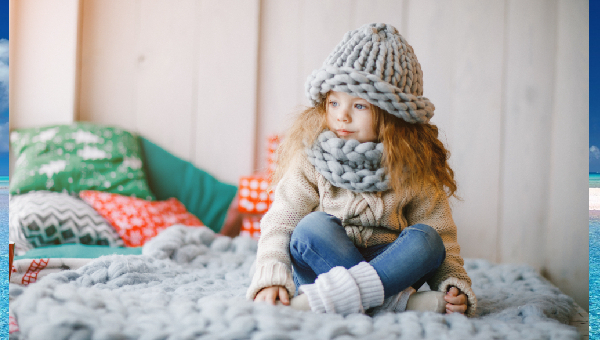April Fool’s Day for Kids: Fun and Safe Pranks for Little Jokers
Winter Warmth: How to Properly Layer Your Kids for the Cold Season

Winter is awesome with snow, different holidays, and opportunities to play in the cold, but the cold can be treacherous for children. In winter, as every parent can understand, being warm, comfortable and safe is of paramount importance for the children. Superimposition appears to be important when dressing your child for winter so they can easily adjust to changes in conditions. Let us take you through these steps in this article to ensure you get your kids properly layered for the cold seasons.
Why Layering is Important
Poly-layering is a technique seen where one wears many clothes so that they accumulate warmth on the body. Fashion layers allow the parent to add or remove garments as the situation and, especially the weather, demands. This is much better than depending on one thick jacket; though bulky, this replaces several layers of thinner clothing. Layering is so useful as it provides your kids with a warm outfit for outside play, as well as clothes for going to school. This helps to avoid such things as overheating, and subsequently, sweating, and even chilling of the body once the sweat cools off.
The Three Layers of Winter Clothing
To properly layer your child for winter, it's important to understand the three essential layers: they are the base layer, middle layer and outer layer. Although both serve the purpose of keeping your child in comfort by keeping him or her warm and dry, both are uniquely important.
Base Layer: The Foundation of Warmth
The first layer of defence against cold is the base layer. This layer is in close contact with your child’s skin therefore it needs to be gentle on the skin and should not retain moisture. Works, directly to the base layer, to extract moisture from the body that keeps your child's skin dry. It also assists in avoiding sensations of chill due to sweating which everyone finds uncomfortable to have. Merino wool is the best for the base layer because it has naturally more absorbent ability and better thermoregulation capacity. That is why materials such as polyester, which suit more spaciously high-spirited children would be good since it dries more quickly and costs less. What to look for:
- Fabric: Select fabrics that are moisture-transferring including merino wools or synthetic ones like polyester. Do not use cotton because they are damp hence your child will feel uncomfortable and cold.
- Fit: This layer should be tight but not very tight around the body. A well-fit tight layer is more favourable for heat conservation, evaporative rate, and moisture management.
- Top and Bottoms: Base layers are usually in the form of long-sleeved t-shirts, and leggings. However, make sure to slip the upper part of the body as well as the lower part to prevent coldness.
Middle Layer: Insulation for Heat Retention
The second layer is insulating- it locks in the heat produced by your child. This is the layer which is the most significant one if somebody is concerned with warmth since this layer is expected to retain heat. For those slightly colder conditions, a down vest or jacket is great as a mid-layer piece of clothing. Down is very light and offers great warmth retention. The second great choice is the fleece jacket where you can be sure that your child will be protected from the cold while not overheating. This kind of fleece garment is good for wearing in layers and thus can be worn as over garments during moderate weather conditions. What to look for:
- Fabric: Fleece, down, and synthetic fill are very good for the middle layer of the insulation. Fleece is very light and air-conditioned while down is very warm. There are special types of insulation, such as Thinsulate, that provide insulative qualities regardless of their condition, and humidity especially in a cold climate.
- Fit: Ideally the middle layer should also be able to provide circulation of air while also trapping heat to ensure that it is not too bulky for movements around the area.
- Flexibility: Select a middle layer that can be interchanged or removed depending on the conditions of the environment. Clothing of fleece, lightweight, (jacket or vest) is useful since it affords warmth without extra pounds.
Outer Layer: Protection from Wind and Water
The outer layer is your child’s shield against unfavourable physical conditions the outer garment serves as a protective shield for your child against harsh weather conditions. This layer should shield your child from wind, rain or even snow but let the moisture from the inner layers evaporate. Besides, the outermost layer ought to be broad enough to hold the other layers but should neither be large nor ragged. What to look for:
- Waterproofing: It should be also important for a good winter coat to shield a person from water in one form or form else in the frozen season hence it should be waterproof or water resistant. Some of the richest features include attempting to get a jacket with a durable water-repellent (DWR) finish.
- Windproofing: The outer layer must let nothing but cold air in and this means that it has to effectively shut out wind.
- Breathability: Shelter from rain and wind is always desirable, but so is the ability to let the material ‘breathe’. Select a coat or jacket with some type of flap or zipper so that air can get out but the cold air cannot get in.
- Breathable Fabric: Fabrics such as Gore-Tex are both waterproof and wind-resistant to guarantee your child will be dry and warm.
Other Factors that Add that Finishing Touch
The three main layers are vital to staying warm during the winter, but accessories must not be forgotten when dressing your child. Gloves may be more practical for daily wear; mittens go best in winter if one’s intention is to come out to play. Heated fingers are covered, keeping them in a cluster as opposed to gloves that have separate fingers for each one. Here’s a quick guide to the must-have winter accessories:
- Hats: A cap which must cover the ears is also needed for retaining heat in the body system. When selecting youngsters' garments opt for those made from fleece or wool for added warmth and comfort.
- Gloves or Mittens: It is warmer when you are wearing mittens instead of gloves when skiing as fingers can warm each other. For greater protection go for waterproof mittens.
- Scarves or Neck Gaiters: The comfortable and easily worn headwear, particularly a scarf or neck gaiter shields the neck and face from cold winds. The appropriate material for this accessory should have absorbent characteristics and should not absorb moisture; this fabric is a fleece.
- Boots: This is especially so if the boots will be used for activities where feet will come into contact with water and surfaces with slippery coatings, the waterproof boots with warm insulation and non-slip soles will ensure that your child’s feet remain warm and dry throughout the day.
- Socks: Synthetic or wool in particular is suitable for the winter because they are able to pull away moisture and still remain warm.
How to Dress Your Child for Winter
Besides the layers concept, there are a few ideas that can help to dress children easily and effectively for winter.
- Dress in Layers, Not Bulky Clothes: The clothing fibres they should avoid are that thickness that makes them bulky and they hinder movement in the game. Thus, wear closer, well-fitted clothing material that insulates heat but not the thick clothing material.
- Adjust Layers Based on Activity: For example, if your child is playing outdoors, they may wear a jacket or a sweater, get hot, and remove them. Always ensure they are dressed in layers of clothing that can be easily un-designed and put back on in case of too much heat.
- Check for Comfort and Mobility: Ensure that your child has ease of movement in each layer. It should allow them to run and play without feeling like something is holding them back. Wearing too many layers of clothes is uncomfortable, and it may be quite challenging for your child to encourage them to exercise during an outdoor activity.
- Monitor Temperature and Adjust Accordingly: Check on the feelings of fun or discomfort of your child. He or she should regulate their clothing to avoid overheating or being too cold in case they get out of their comfort zone. Make sure they have a cooler and check their temperature now and again, especially during a day out, when they will be involved in several activities, where they may get tired.
- Use High-Quality Materials: Choose expensive winter clothes – they will serve you longer and do a better job at keeping you warm and protecting you from the cold. Better fabrics also provide the feature of breathability and moisture management which is vital to warmth retention.
- Don’t Forget About the Neck and Face: A warm air blowing down their throat and neck always feels even colder to a child, and this can be covered by using scarves, neck gaiters, or face masks. Ensure that there is a little tightness on the neck region but enough to allow breathing.
Conclusion
The various clothing layers should also be correctly worn by children when dressing them up during winter and focusing on options such as the bottom and middle layers as well as outerwear and accessories guarantees safe winter outdoor fun for children, such as outfitting for your child. It is important to remind you that layering is all about being as flexible and as comfy as you only can. That’s the way, when you layer smartly, you will help your child to have lots of fun in winter and at the same time he or she will be kept warm and well protected from the chilling effect of the frozen winter weather.








